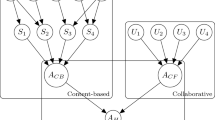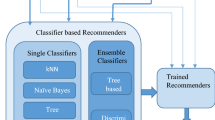Abstract
Recommender system has emerged as a new research concept in the economic field, in which a new recommend algorithm such as stock data mining plays an important role in studying the level of economic development in a region. A novel recommends method of big data analysis method based on singular value decomposition is proposed. The proposed algorithm exploits the historical data of stocks in the western region, the regional leading stock average data and volatility of individual stocks data. Then volatility charts could be gotten from data mining. The stability of the western region stock could be drawn by comparison between leading stocks and common stocks. Money flow of stocks can also be calculated by new recommender system algorithm. The experimental results show that our approach has ability to forecast the economic development of the western region by the perspective of stock data mining. It could effectively recommend investors to identify the economic development of the western region, obtaining higher returns, and avoiding unnecessary losses.













Similar content being viewed by others
Change history
20 September 2022
This article has been retracted. Please see the Retraction Notice for more detail: https://doi.org/10.1007/s11042-022-13985-8
References
Bo C, Wen-Sheng C (2011) Noisy image segmentation based on wavelet transform and active contour model [J]. Appl Anal 90(8):1243–1255
Bo C, Yan L, Jin-Lin C (2012) Noise image segmentation based on nonlinear diffusion equation model[J]. Appl Math Model 36(3):1197–1208
Bo C, Qing-Hua Z et al (2012) A novel adaptive partial differential equation model for image segmentation [J]. Appl Anal 93(11):2440–2450
Bo C, Qinghua Z, Yan L (2015) A new image segmentation model with local statistical characters based on variance minimization[J]. Appl Math Model 39(12):3227–3285
Chen Z-M, Xiong X (2016) Equilibrium states of the Charney-DeVore quasi-geostrophic equation in mid-latitude atmosphere [J]. J Math Anal Appl 444(2):1403–1416
Chengying H, Rui C (2014) Investor overconfidence and unsustainable contrarian stock market[J]. Management World 11(8):44–54
Chengying H, Lin L, Xiangyang X (2013) Foreign intervention, exchange rate movements and stock price fluctuations[J]. Economic Research 10(1):29–42
Claire H, Kevin D (2001) Multifractal analysis of hang seng index in Hong Kong stock market[J]. Physical A Statistical Mechanics & Its Applications 291(1):553–562
Fangli Y, Yanying Y et al (2011) Matrix singular value decomposition and its application in high dimensional data processing[J]. Mathematics in Practice and Theory 41(15):171–177
Fushan L, Qingyong G (2016) Blow-up of solution for a nonlinear Petrovsky type equation with memory [J]. Appl Math Comput 274:383–392
Han L, Lili L, Lingshuai H (2015) Two-stage image Denoising using patch-based singular value decomposition[J]. Acta Automat Sin 41(2):439–444
Hong C, Rongyao C (2011) Stock price prediction based on PCA and BP neural network [J]. Computer Simulation 28(3):365–368
Jia N, Yu L, Yang KX et al (2016) A novel exercise Thermophysiology comfort prediction model with fuzzy logic[J]. Mob Inf Syst. doi:10.1155/2016/8586493
Naishuo T, Zhanyou M (2008) The discrete time Geom/Geom/1 queue with multiple working vacations[J]. Appl Math Model 32(12):2941–2953
Peihe W, Dekai Z (2017) Convexity of level sets of minimal graph on space form with nonnegative curvature [J]. Journal of Differential Equations 262:5534–5564
Peihe W, Lingling Z (2016) Some geometrical properties of convex level sets of minimal graph on 2-dimensional Riemannian manifolds [J]. Nonlinear Analysis: Theory, Method& Applications 130:1–13
Qi L, Yongyi G (2016) Scale invariant representation of imbalanced points[J]. Neurocomputing 173(3):1422–1435
Qingzhen X (2013) A novel machine learning strategy based on two-dimensional numerical models in financial Engineering[J]. Math Probl Eng. doi:10.1155/2013/659809
Qingzhen X, Feifei Z (2016) A novel model of stock data mining with M/G/1 queue for evaluation of stock crash[J]. International Journal of Database Theory and Application 9(5):37–44
Qingzhen X, Jiayong W (2014) A novel mobile Personalized recommended method based on money flow model for stock exchange [J]. Math Probl Eng. doi:10.1155/2014/353910
Qingzhen X, Susu B et al (2007) Mx/G/1 queue with multiple vacations[J]. Stoch Anal Appl 25(1):127–140
Qingzhen X, Zhoutao W et al (2017) Thermal comfort research on human CT data modeling. Multimedia Tools and Applications. doi:10.1007/s11042-017-4537-9
Xiangyang D, Yongsheng W, Yongsheng S (2009) Research on signal feature extraction method based on singular value decomposition[J]. Journal of vibration and shock 28(11):30–33
Xiaoying S, Xiaojing L (2012) Application of data mining in stock price prediction[J]. Computer Simulation 29(7):375–378
Xiuli L, Zengqin Z (2013) Existence and uniqueness of symmetric positive solutions of 2n-order nonlinear singular boundary value problems [J]. Appl Math Lett 26:692–698
Xiuli L, Zengqin Z (2014) Sign-changing solution for a third-order boundary-value problem in ordered Banach space with lattice structure [J]. Bound Value Probl 1–10. doi:10.1186/1687-2770-2014-132
Xiuli L, Zengqin Z (2016) Iterative technique for a third-order differential equation with three-point nonlinear boundary value conditions [J]. Electronic Journal of Qualitative Theory of Differential Equations 12:1–10. doi:10.14232/ejqtde.2016.1.12
Yang Z (2012) Stock price forecast based on the length of after-effect time[J]. Computer Simulation 29(2):378–381
Yihui G, Shujin L (2016) A 3D model perceptual feature metric based on global height field[J]. Vis Comput 32(9):1151–1164
Yongle L, Rongling L, Jiacheng L (2009) Decision of threshold for singular value decomposition filter based on SNR’s empirical value[J]. Application Research of Computers 26(9):3253–3255
Yuejuan J, Bingheng L (2016) Study of 3D printing-based internet manufacturing mode[J]. Comput Integr Manuf Syst 22(6):1424–1433
Yunhong W, Tieniu T, Yong Z (2000) Face identification based on singular value decomposition and data fusion[J]. Chinese Journal of Computers 23(2):649–653
Yurong C, Shuangbing G (2003) Stock price Predition based on analysis of chaotic time series [J]. Journal of University of Electronic Science and Technology of China 32(4):469–472
Zhanyou M (2008) General decrementing service M/G/1 queue with multiple adaptive vacations[J]. Appl Math Comput 204(1):478–484
Zhongxin J, Xiaofang L (2008) Prediction of stock price trends by Markov chains[J]. Chinese business community 14(11):32–33
Zhu J, Fung G, Wong W (2016) Evaluating the pros and cons of different peer review policies via Simulation[J]. Sci Eng Ethics 22(4):1–22
Acknowledgements
This work was supported by Guangdong Provincial Public Research and Capacity Building Foundation funded project under Grant No. 2015A020217011, &2016A020223012, Science Foundation of Guangdong Provincial Communications Department under Grant No. 2015-02-064, the National Natural Science Foundation of China under Grant No. 61402185, and Natural Science Foundation of Guangdong Province under Grant No.2015A030313382. The authors would like to thank the anonymous reviewers and the editor for the very instructive suggestions that led to the much improved quality of this paper.
Author information
Authors and Affiliations
Corresponding author
About this article
Cite this article
Yang, J., Li, J. & Liu, S. RETRACTED ARTICLE: A novel technique applied to the economic investigation of recommender system. Multimed Tools Appl 77, 4237–4252 (2018). https://doi.org/10.1007/s11042-017-4752-4
Received:
Revised:
Accepted:
Published:
Issue Date:
DOI: https://doi.org/10.1007/s11042-017-4752-4




